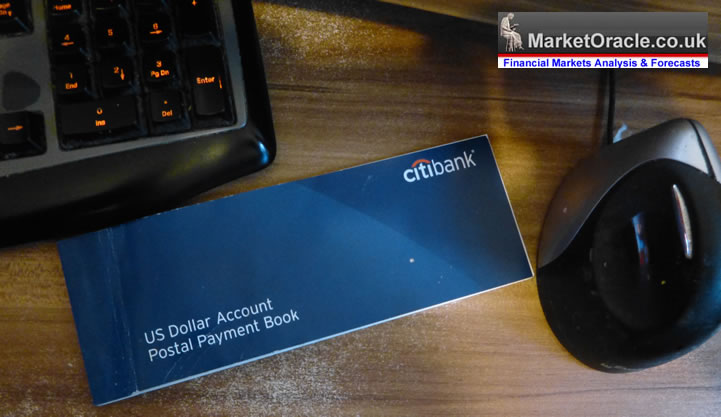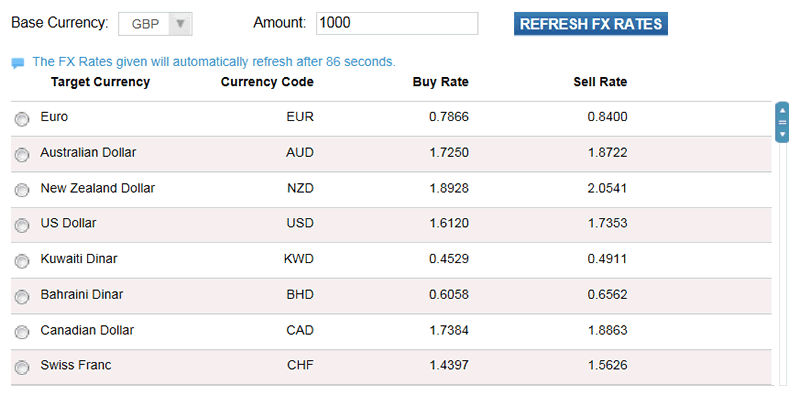Once upon a time the Citibank USD current account was by far one of the best such accounts on the market for depositing USD cheque's in the UK, where typically 1.75% was added to the spot GBP exchange rate and if lucky at best as little as 1.5% or at worst rarely more than about 2.2% with no other fees as long as £2,000 or equivalent was always kept on deposit.

However, things started to change a couple of years ago when Citibank introduced a £5 ($8) charge per cheque deposited the immediate effect was to make deposits of small amounts unviable. For instance this fee translated into an additional cost of 0.8% on a $1k cheque deposit the effect of which was an increase of charges experienced to a range of 2.3% to 3.05% per USD cheque. Which when compared against competitors at the time was still was deemed to be a good deal.
If Citibank had stayed put at that than Citibank would still have remained one of the best USD current accounts on the market as the great advantage is that Citibank customers get to choose online when to make the currency transfer and therefore can better time transfers rather than to be left at the mercy of banks that effectively tend to CHOOSE the WORST rate over a 2 week period.
So despite the minimum transfer fee slowly creeping up to 2% to 3% (plus £5 fee), the ability to select rates offered customers a significant advantage over customers of other banks.
However lately, following the most recent Citibank changes the spread has now apparently jumped substantially to a minimum of 3% and as high as 4% with a typical rate offered of 3.6% for a $2k transfer (4.6% for less than $2k). Therefore more than twice the rate citibank used to typically charge a couple of years ago.
For instance the following table illustrates the actual citibank rates given this week on rate tests today and yesterday.
| Offered | Spot | % Added |
|---|---|---|
| 1.732 |
1.6716
|
3.61%
|
| 1.731 |
1.6707
|
3.62%
|
| 1.7307 |
1.671
|
3.57%
|
Up until 2 weeks ago the typical % added was 2.34%, that now for no apparent reason has been increased by near 1.3%.
The below table better illustrates the effect of the change in charges over the past few years on typical dollar cheque deposit amounts.
| 2011 Fee | May 2014 Fee | |||
|---|---|---|---|---|
| $500 |
$8.75
|
1.75%
|
$31
|
6.2%
|
| $1000 |
$17.5
|
1.75%
|
$54
|
5.4%
|
| $2000 |
$35
|
1.75%
|
$80
|
4%
|
| $5000 |
$87.5
|
1.75%
|
$188
|
3.8%
|
So today a $5000 USD cheque deposit carries more than twice the fee charged in 2011 and a far greater % for smaller amounts.
Citi UK Reference Exchange Rate
Citibank exchange rates are hidden away on the website under the Investment & Deposits / FX Buy and Sell menu tab when logged in.

The table illustrates the huge GBP spread between buying and selling of 7.65%, more than twice what it used to be a couple of years ago.
The bottom line is that many Citibank USD cheque deposit customers will be wasting their time trying to transfer at a decent rate that is for instance 2.3% above the spot rate but the reality that they now face is that they will be lucky to obtain a rate of spot +3%, and more likely be lumbered with spot+3.6% that is in addition to the £5/$8 cheque deposit fee.
Time to start looking to a better alternative to Citibank USD banking.
Source and comments: http://www.marketoracle.co.uk/Article45824.html







